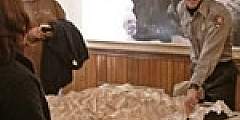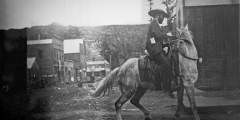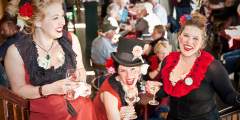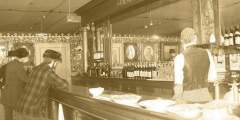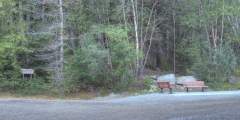Step back in time and explore historic Skagway using our detailed walking tour.
Show Map
Walking Tour Points
Railroad Houses were a sign of Skagway’s maturity after the gold rush. For many years, Skagway resembled a company town; most of the family bread winners worked for the WP&YR railroad. To make life more comfortable for its officers, the company built and made available nine homes in town. Three are seen here. Although the company suspended service to White Horse in 1982, it reopened as a summer tourist railway in 1988.White Pass is still… ...more
As a nearby marker testifies, this corner marks the scene of the Reid-Smith Gun Battle. Near here, criminal kingpin Jefferson R. “Soapy” Smith and surveyor Frank Reid shot it out on the evening of July 8, 1898. Just four days earlier, Smith was the undisputed leader of Skagway. He had been chosen as the grand marshal for the July 4th parade, and was cheered by his fellow citizens. On the 8th, however, a stampeder just back from the Klondike… ...more
A good place to start any tour of Skagway is the former White Pass and Yukon Railroad Depot. This massive, colorful structure, built in 1898, was a dominant part of Skagway life until 1969, when railroad operations moved to the WP&YR’s new building two doors east. The old depot is now the National Park Service Visitor Center, where visitors can enjoy movies, walking tours and other activities during the summer. Although the tracks are now… ...more
One of Skagway’s best-known characters, for better or worse, was Jefferson Randolph “Soapy” Smith.. He was not a man to be taken lightly. He was a well-established con man throughout the west of the United States and was the epitome of the word crook.
Buxom Red Onion Madams in come-hither costumes call out from their perches, while waitresses in corsets and petticoats serve food and drinks: there’s no place in Alaska quite like the Red Onion Saloon, a bar, restaurant & museum set in what was once a real bordello… The atmosphere is lively and the tours are bawdy, fun, and flirtatious — how else to run a tour of a brothel museum? Plus, their bar and restaurant is one of the most happening… ...more
At the corner of 3rd and Broadway lies the Mascot Block, a row of three separate business buildings. The Mascot Saloon, on the corner, dates back to 1898. It was one of more that 80 saloons in a town once described as “the roughest place in the world.” The saloon operated until August 1916, when Prohibition closed it down; it later served as a drug store. Next door sits the old Pacific Clipper Line office. Skagway was an active port both… ...more
The best Gold Rush bar in town features over 100 original reindeer and Coors beer bottles as well as some pre-Prohibition artifacts.
The St. James Hotel, presently a hardware store warehouse, is famous as the birthplace of the White Pass and Yukon Route railroad. During the winter of 1897 – 98, it took tremendous effort for the stampeders to haul the required ton of goods” from Skagway to the Canadian lakes. To ease the strain, several tramways and railroads crossing White Pass were proposed, but the plans were long on speculation and short on money. Into this atmosphere came… ...more
The large, three-story Pack Train Building is the tallest historic building in Skagway. The three buildings that make up this block date from 1900, but like many others on Broadway, they were first located elsewhere. These were originally barracks that once comprised part of Camp Skagway, located two blocks up Broadway on 6th Ave. The military abandoned them when it moved to the Haines area in 1904, and four years later, they were moved here.… ...more
Across the street, the Skagway Customs building was built by the WP&YR railroad and leased to the government. It originally sat on the south side of 2nd Ave. adjacent to the railroad depot. In 1969, with the construction of the new depot, the building was moved across the street to the north side 2nd Ave. After the Klondike highway opened in the fall of 1978, the offices were moved to a location on the highway. For a time after the customs… ...more
The Moore Cabin is the oldest structure in Skagway. It was built by Captain William Moore and his son in 1887 – 88. Moore was 65 years old when he arrived. He had followed gold rushes all his life, and settled here to pursue one more chance at a fortune. When the big rush came, his land was overrun by a flood of gold seekers. But he prospered because he owned a dock, a ware house and a sawmill. He stayed here until 1906, long enough to see his… ...more
A small bust, just west of the public rest rooms, in the corner of Mollie Walsh Park, proclaims the memory of a remarkable woman. Mollie Walsh came to Skagway, unaccompanied, in the fall of 1897. A rarity in her day, she was young, unmarried and at least somewhat respectable. She remained in Skagway for a few months, then headed north to open a restaurant in Log Cabin, a tent town located along the White Pass Trail. She soon received the… ...more
The McCabe College building, currently occupied by the Skagway Museum and City Hall, was built in 1899 of native granite brought from Clifton on the WP & YR railroad. The Methodist school, named for Bishop McCabe, was Alaska’s first institution of higher education. Facing financial difficulties, private McCabe College closed after only three terms. From 1901 until 1956, the building served as the U.S. Court House with the U.S. Marshal’s… ...more
Along 7th Avenue between Broadway and State Street, is the Gutfeld Residence (Historic Skagway Inn). Built using materials from an 1897 – 1898 building, Max Gutfeld built this residence in 1918. In the 1920’s the rear wing was added by moving the vacant Ross-Higgins warehouse (1901) from 4th Avenue and Main Street to the present site. This street is the site of Skagway’s once thriving Red Light District. As was true in most frontier towns,… ...more
The First Presbyterian Church, located at 5th and Main, is Skagway’s only remaining gold rush church. It was built in 1901 by the Methodists, but in a denominational realignment, that church body vacated Skagway in 1917.The Presbyterians, who had lost their church building to afire the previous year, moved in and have remained ever since. During the gold rush, Skagway had but one house of worship, the Union Church. But by 1900, several other… ...more
The plantation-style White House was built in 1902, and was originally the home of Lee Guthrie, saloonkeeper and civic official. After Guthrie left town, the house was converted into a small hotel. The Army used it for a small hospital during World War II. The building’s name occasionally caused delightful confusion. One story about it dates back to 1956, when a Republican campaign worker stopped by to visit. No one responded to the knock, but… ...more
This is where Jefferson Randolph “Soapy” Smith and Frank Reid are buried. Both men shot and killed each other in a gunfight in July 1898. Locate Frank Reid’s grave and you’ll find a short hiking trail to Reid’s Falls.


